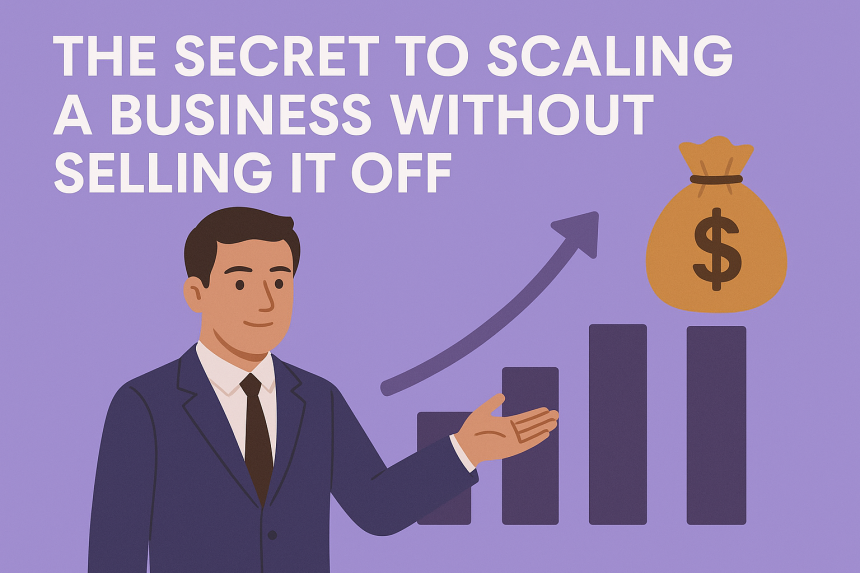Every business owner eventually hits a fork in the road. Growth is tugging at the sleeves, competitors are circling, and the IRS feels like it’s moving rent-free. The traditional options for moving forward all come with trade-offs. Selling the company means losing control. Taking on private equity means fielding phone calls from people who care more about quarterly returns than the legacy you’ve built. Doing nothing can feel like bleeding out slowly. But there’s a different path—one that allows owners to expand, plan for succession, or take chips off the table without losing the company in the process. It’s called an ESOP, and it’s quietly becoming one of the most effective tools for mid-market companies that want to stay both profitable and independent.
Why The Old Playbook Doesn’t Work Anymore
For decades, the playbook was straightforward: grow the business until an acquirer comes calling, or pass it along to family if they’re interested. But the old methods don’t always fit today’s realities. Buyers are more aggressive, deals often strip the heart out of a company, and second-generation heirs may not want to step into ownership. On top of that, taxes on a major liquidity event can easily strip away millions that might have gone back into reinvestment or retirement.
That tension has left many owners stuck. They want growth but don’t want to surrender their life’s work to strangers. They want liquidity but can’t stomach the tax hit that comes with selling outright. ESOPs fit neatly into this gap, offering owners a way to meet the business’s needs without compromising what they value most.
How ESOPs Shift The Power Balance
At its core, an Employee Stock Ownership Plan is a retirement vehicle structured to hold company stock. But calling it just that undersells its potential. In practice, an ESOP lets an owner sell some or all of their shares to a trust, with the company making contributions over time to buy them out. That means liquidity for the seller, a steady repayment structure, and—here’s the kicker—major tax advantages.
When structured properly, ESOP-owned companies can defer or even eliminate federal income tax entirely. That’s not just a line item improvement—it can be the difference between a company scraping to reinvest and one that has free cash to scale aggressively. Owners often use that advantage to fuel acquisitions, expand product lines, or shore up infrastructure, all while maintaining control.
This isn’t charity. It’s a strategy. While the plan is technically for employees, the driving force is efficiency and control. That’s why industries from construction to tech are embracing ESOPs. Even in areas considered more “taboo,” like cannabis, the model offers owners a way to grow while navigating uniquely punishing tax codes.
What First-Time Business Owners Need To Know
The mechanics of an ESOP can sound intimidating, especially if you’re a first-time business owner still figuring out the alphabet soup of tax and finance. But think of it like a tailored suit. Off-the-rack solutions rarely fit, and trying to cram into one usually leaves you uncomfortable. An ESOP, on the other hand, is custom-built for your company’s structure, goals, and long-term vision.
Yes, it requires lawyers, accountants, and valuation experts to set up. But the payoff is clarity. Instead of wondering how you’ll eventually exit or pass things along, you have a roadmap that not only handles that but also puts you in a stronger tax position immediately. For someone in their first venture, knowing that growth won’t automatically mean handing over a giant check to the IRS can be liberating.
It also shifts how you think about financing. Banks often see ESOP companies as lower risk because of their tax efficiency and long-term stability. That means better access to credit lines, smoother acquisition financing, and leverage you wouldn’t have otherwise. In other words, the upfront complexity pays for itself in long-term freedom.
Why ESOPs Fit Everywhere
One of the most striking things about ESOP adoption is the sheer range of industries finding success with it. You’ll see companies in highly regulated markets—like an ESOP for cannabis companies, home care and everything in between—using the structure to navigate their unique tax landscapes. In one case, it’s about shielding revenue from punitive rules. In another, it’s about setting up a smooth handoff to the next generation of caregivers.
This diversity underscores a bigger truth: ESOPs aren’t about industry; they’re about outcomes. They let owners tailor succession plans without giving up equity to outsiders. They allow companies to keep cultural DNA intact while scaling nationally. And they give industries as different as home health and retail distribution the same financial toolkit to grow without compromise.
The key is flexibility. Whether you’re running a fast-scaling healthcare network or a regional cannabis operation, the structure adapts. That adaptability has made ESOPs one of the few ownership strategies that’s both niche-specific and broadly applicable.
The Ownership Myth
It’s easy to assume that ESOPs exist to give employees a sense of ownership and warm feelings about their employer. While that’s technically true—the employees do benefit from the trust—the real driver isn’t emotion. It’s math. Owners aren’t using ESOPs as a perk; they’re using them as an instrument to solve problems that traditional paths don’t address.
The myth is that ESOPs are about generosity. The reality is they’re about efficiency. Owners stay in control, taxes shrink, and succession becomes less of a cliff dive and more of a glide path. Employees simply happen to benefit as a byproduct, building retirement wealth along the way. That dual benefit explains why companies that adopt ESOPs tend to see higher retention and engagement without even trying to manufacture culture.
It’s the rare scenario where alignment isn’t forced but flows naturally from the structure itself. The owner wins, the employees win, and the company becomes a safer bet for lenders and partners.
Preparing For Growth Without Selling Out
The strongest reason owners turn to ESOPs is the ability to prepare for the future without compromising their present. Growth often demands capital, and exits often demand painful decisions. ESOPs bridge the two. An owner can sell a portion of the company into the trust, free up liquidity, reinvest tax-advantaged profits, and still retain control of day-to-day decision-making.
That control matters. Selling to a private equity firm or strategic buyer might mean watching your company culture hollow out within months. It might mean answering to someone else’s board. For owners who’ve spent decades building something more than just a revenue stream, that loss can sting more than the sale price helps. ESOPs let owners avoid that trade-off altogether.
It’s not a tool for everyone—companies need stable cash flow, strong management, and a willingness to engage with the legal and financial setup. But for those who meet the profile, the upside can redefine what growth and succession look like. Instead of seeing expansion as a prelude to losing control, owners can frame it as the start of their next chapter on their own terms.
Closing Word
Every business owner faces the question of what comes next. Some rush toward buyers, some pass the baton to family, and some grind it out until they can’t anymore. ESOPs carve out a different lane, one that doesn’t force a sale or sacrifice control. They turn succession and scaling into a tax-efficient strategy rather than a leap into the unknown.
For the owners who’ve felt boxed in by limited options, the ESOP isn’t just an alternative—it’s the blueprint for keeping both their company and their legacy intact. And that’s a secret too good to keep quiet.
Lynn Martelli is an editor at Readability. She received her MFA in Creative Writing from Antioch University and has worked as an editor for over 10 years. Lynn has edited a wide variety of books, including fiction, non-fiction, memoirs, and more. In her free time, Lynn enjoys reading, writing, and spending time with her family and friends.















